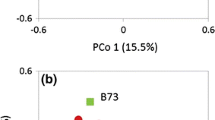Abstract
Sweet corn has poor cold tolerance and adaptation to the European Atlantic coast. Our objectives were to identify sources of favorable alleles for improving cold tolerance of three sweet corn hybrids, to compare sources of cold tolerance and early vigor, and to provide additional information on the relationships among different classes of loci and estimators of favorable alleles for cold tolerance. Each of ten field corn populations was crossed to four sweet corn inbreds. The field by sweet corn hybrids, the populations, the inbreds and the target hybrids were evaluated under cold conditions. Estimates of the mean frequencies of four classes of loci in the populations, and six estimators of favorable alleles (lplμ', PTC, UBND, NI, PNGg, and PNGceg) and GCA were computed. The population by inbred crosses were significantly different for emergence proportion and survival. Correlations between lplμ', UBND, PTC and NI were high for emergence proportion. Most estimates of favorable alleles were significantly different from zero but not among populations. PTC was used to choose the best potential donor populations. The US Corn Belt Dent population AS-3(HT)C3 and the Spanish flint population Oroso were the best potential donors of favorable alleles for emergence proportion and survival under cold conditions, respectively. The ability to germinate and survive under cold conditions may be necessary, but it does not ensure adaptation to cold humid springs.
Similar content being viewed by others
References
Bernardo, R., 1990. Identifying populations useful for improving parents of an elite single cross based on net transfer of alleles. Theor Appl Genet 80: 349-352.
Cartea, M.E., R.A. Malvar, P. Revilla & A. Ordás, 1996a. Identification of field corn populations to improve sweet corn for Atlantic European conditions. Crop Sci 36: 1506-1512.
Cartea, M.E., R.A. Malvar, P. Revilla & A. Ordás, 1996b. Improvement of early vigor and adaptation of sweet corn to the European Atlantic coast with open-pollinated field corn populations. Maydica 41: 119-125.
Dudley, J.W., 1984. A method for identifiying populations containing favorable alleles not present in elite germplasm. Crop Sci 24: 1053-1054.
Dudley, J.W., 1987. Modification of methods for identifying populations to be used for improving parents of elite single crosses. Crop Sci 27: 940-943.
Gerdes, J.T., C.F. Behr, J.G. Coors & W.F. Tracy, 1994. Compilation of North American maize breeding germplasm. In: W.F. Tracy, J.G. Coors & J.L. Geadelmann (Eds.), Crop Sci Soc Am, Wisconsin, USA.
Gerloff, J.E. & O.S. Smith, 1988a. Choice of method for identifying germplasm with superior alleles 1. Theoretical results. Theor Appl Genet 76: 209-216.
Gerloff, J.E. & O.S. Smith, 1988b. Choice of method for identifying germplasm with superior alleles 2. Computer simulation results. Theor Appl Genet 76: 217-227.
Hunsperger, M.H. & D.W. Davis, 1987. Effects of the sugary-1 locus on plant and ear traits in corn. Crop Sci 27: 1173-1176.
Kerr, E.A., 1968. Sweet corn inbreds released in dy1967 by the Horticultural Research Institute of Ontario. Hortic Res Inst Ont Rep dy1967.
Malvar, R.A., M.E. Cartea, P. Revilla & A. Ordás, 1997. Identification of field corn inbreds adapted to Europe to improve agronomic performance of sweet corn hybrids. Crop Sci 37: 1134-1141.
Metz, G., 1994. Probability of net gain of favorable alleles for improving an elite single cross. Crop Sci 34: 668-672.
Misevic, D., 1989a. Identification of inbred lines as a source of new alleles for improvement of elite maize single crosses. Crop Sci 29: 1120-1125.
Misevic, D., 1989b. Evaluation of three test statistics used to identify maize inbred lines with new favorable alleles not present in elite single cross. Theor Appl Genet 77: 402-408.
Ordás, A., 1991. Heterosis in crosses between American and Spanish populations of maize. Crop Sci 31: 931-935.
Ordás, A., R.A. Malvar & A.M. de Ron, 1994a. Relationships among American and Spanish populations of maize. Euphytica 79: 149- 161.
Ordás, A., P. Revilla, R.A. Malvar & M.E. Cartea, 1994b. Development of sweet corn hybrids adapted to the environmental conditions of the northwest of Spain. Maydica 39: 171-175.
Ordás, A. & R.E. Stucker, 1977. Effect of planting density on correlations among yield and its components in two corn populations. Crop Sci 17: 926-929.
Peterson, R.H., J.L. Geadelmann, E.H. Rinke & J.C. Sentz, 1976. Registration of six maize germplasm populations (Reg No Gp 64 to 69). Crop Sci 16: 605-606.
Sánchez-Monge, E., 1962. Razas de maíz en España. Ministerio de Agricultura, Pesca y Alimentación, Madrid, Spain.
SAS Institute Inc., 1989. SAS/STAT user's guide, Version 6, 4th ed, Vols 1 and 2. SAS Institute Inc, Cary, North Carolina, USA.
Sprague, G.F. & S.A. Eberhart, 1977. Corn breeding. In: G.F. Sprague (Ed.), Corn and Corn Improvement, 2nd ed, pp. 305- 362. Am Soc Agron, Madison, Wisconsin, USA.
Sprague, C.F. & L.A. Tatum, 1942. General vs. specific combining ability in single crosses of corn. J Am Soc Agron 34: 923-932.
Steel, R.G.D. & J.H. Torrie, 1980. Principles and procedures of statistics. 2nd ed McGraw-Hill, New York, USA.
Tracy, W.F., 1994. Sweet corn. In: A.R. Hallauer (Ed.), Specialty Types of Maize, pp. 147-187. CRC, Boca Raton, Florida, USA.
Treat, C.L. & W.F. Tracy, 1994. Endosperm type effects on biomass production and on stalk and root quality in sweet corn. Crop Sci 34: 396-399.
Zanoni, U. & J.W. Dudley, 1989. Comparison of different methods of identifying inbreds useful for improving elite maize hybrids. Crop Sci 29: 577-582.
Author information
Authors and Affiliations
Rights and permissions
About this article
Cite this article
Revilla, P., Malvar, R.A., Cartea, M.E. et al. Identifying open-pollinated populations of field corn as sources of cold tolerance for improving sweet corn. Euphytica 101, 239–247 (1998). https://doi.org/10.1023/A:1018342204213
Issue Date:
DOI: https://doi.org/10.1023/A:1018342204213




